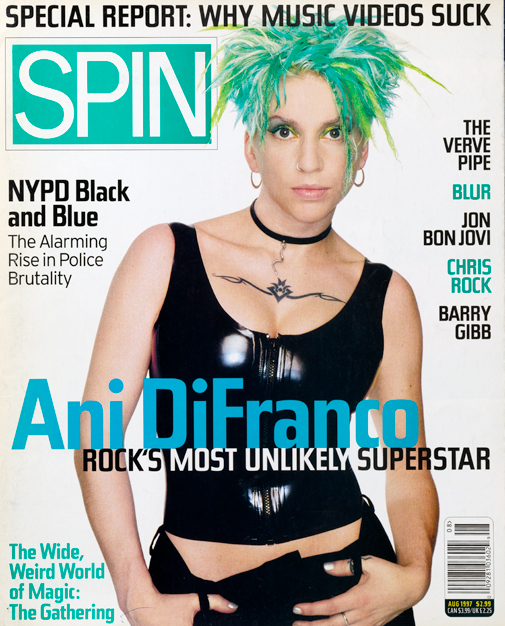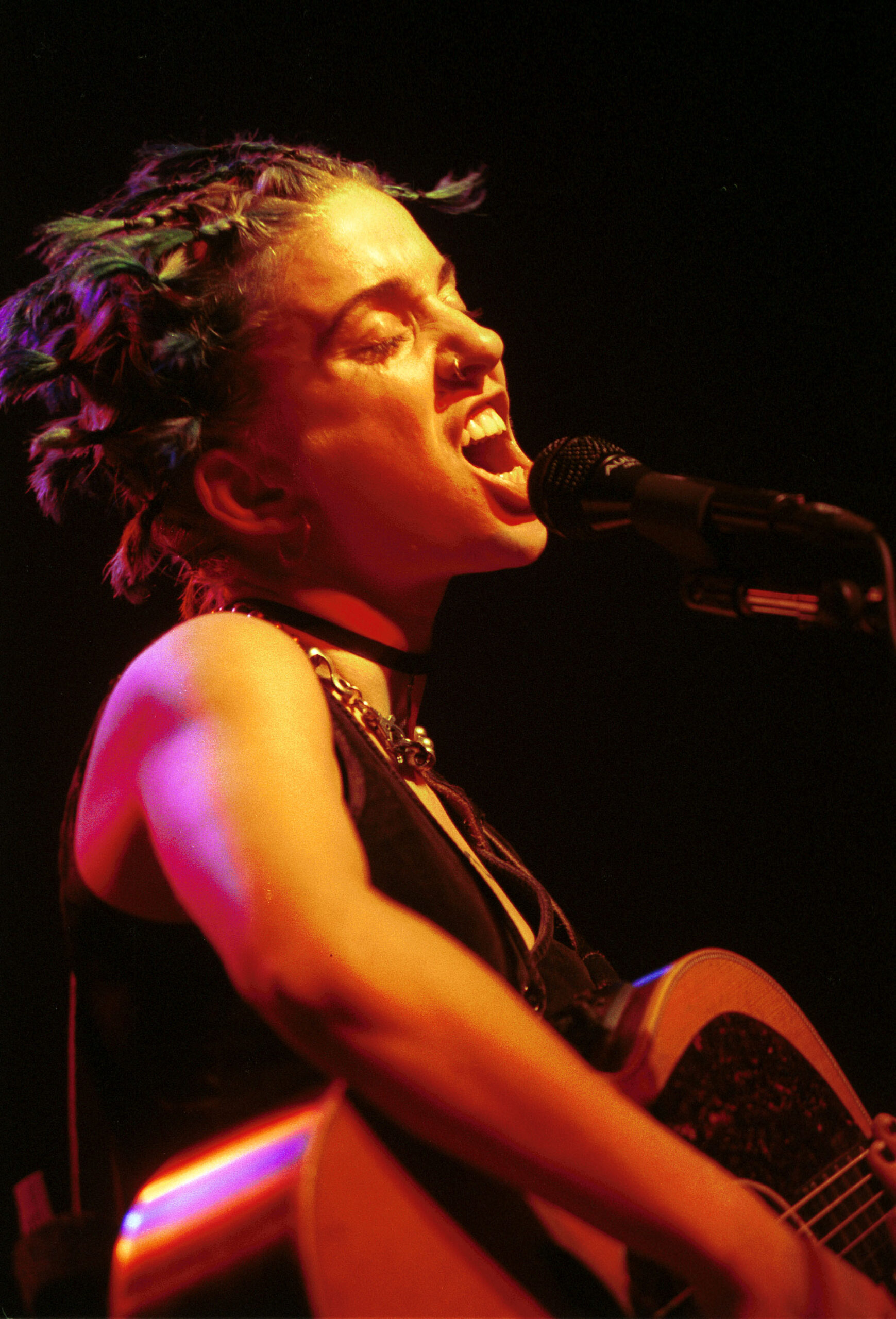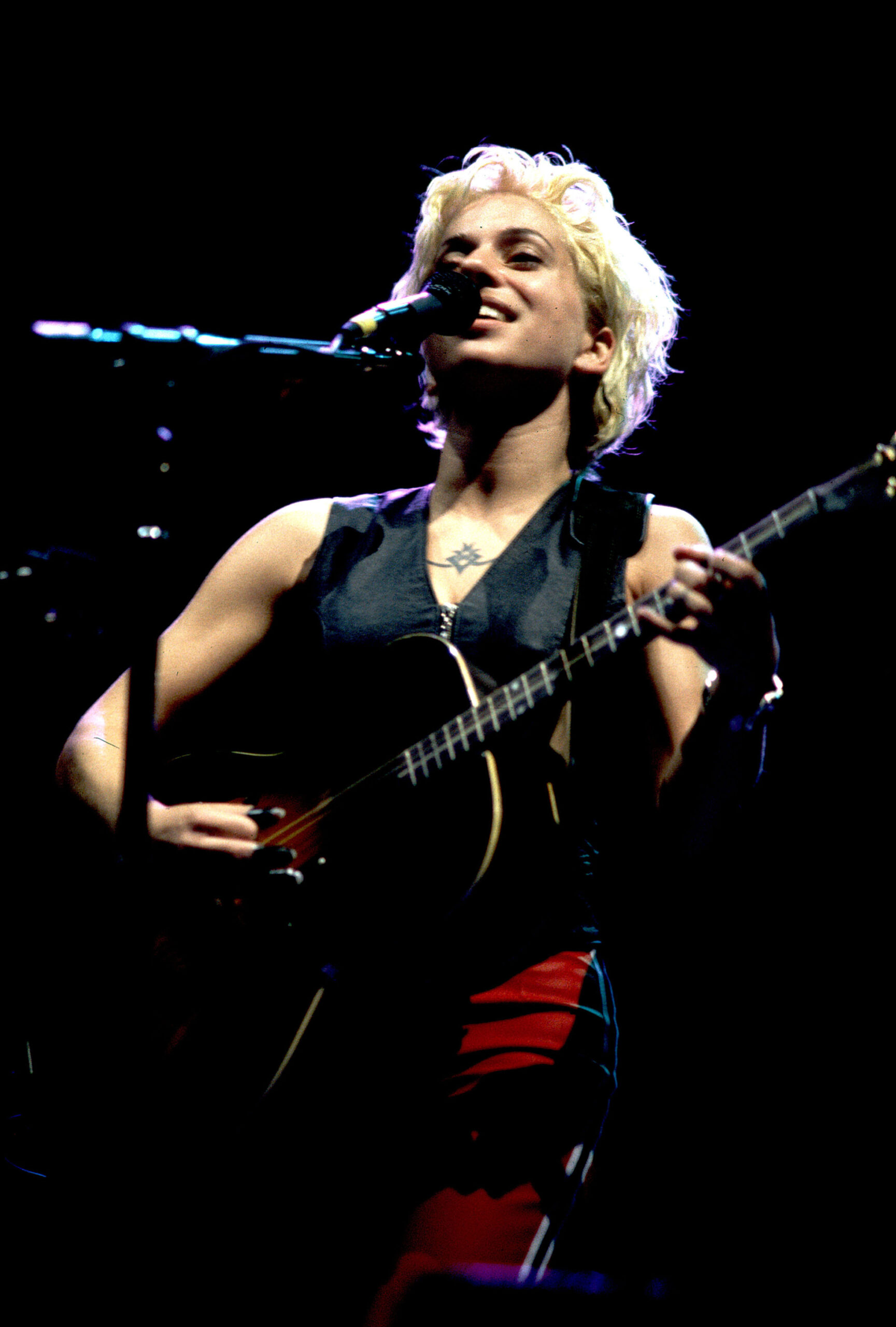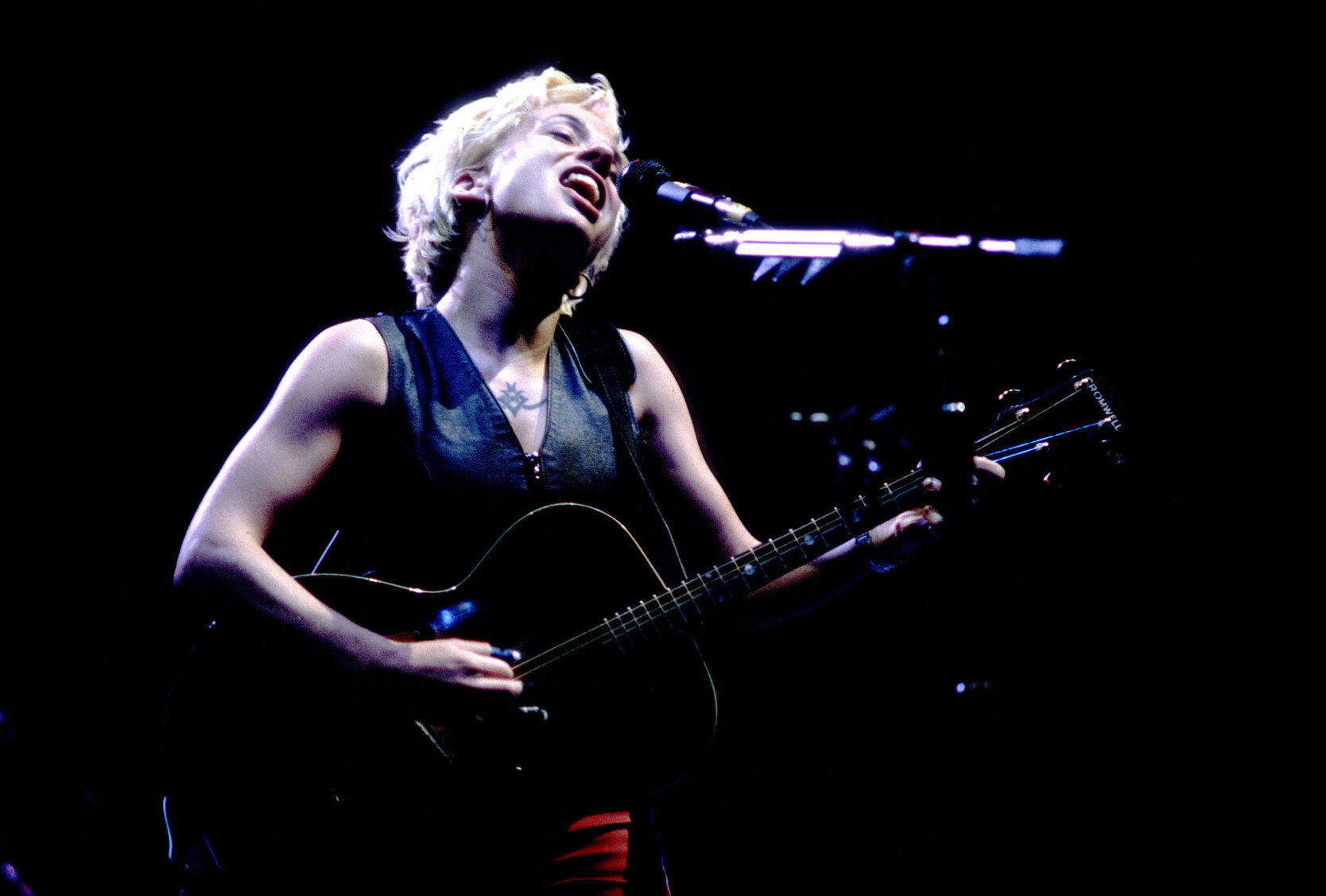This story was originally published in the August 1997 issue of SPIN.
With stardom just a compromise away, Ani DiFranco chides her fans, goofs on the media, and wishes major labels would get the bleep off her answering machine. Jonathan Van Meter uncovers the essential brattiness of folk’s great white hope.
Tonight in Knoxville, Ani DiFranco is onstage at the Tennessee Theater doing one of the two things she does best: talking. She is talking to her audience, her fans, and, oh, what fanatics they are. Pierced, tattooed, obsessed, sexually ambiguous, passionate, young, noisy, bossy, possessive, and demanding. DiFranco’s hair is dyed magenta, her T-shirt is orange, her skintight latex pants are electric lime green. She has never performed here before, and whenever she plays a new town—what her manager calls “breaking in a new market”—it feels a little bit like she’s gone back in time a couple of years, when her audiences were mostly women. New markets always bring out the original, hardcore fans: the dykes.

In a few minutes she will start doing the other thing she does best: making music. She will sing a new song, a song that she’s just recently written. A song that goes, in part, like this:
From the shape of your shaved head
I recognized your silhouette
As you walked out of the sun and sat down
And the sight of your sleepy smile
Eclipsed all other people
As they paused to sneer at the two girls
From out of town
The dykes in the audience will love this song. They will feel validated by it, and why not? It’s classic Ani DiFranco. Who else writes songs about sleepy, smiling, bald-headed girls in a coffee shop, in a small town, getting hostile glances from the locals?
The dykes will feel that this song is about them. What’s not clear, though, is if they will follow the song to its slightly irritated conclusion, and realize that it is, quite literally, a song about them.
People talk
About my image
Like I come in two dimensions
Like lipstick is a sign of my declining mind
Like what I happen to be wearing
The day that someone takes a picture
Is my statement for all womankind…
But I’m getting ahead of myself. She hasn’t sung this song yet. She’s still talking. “It’s a girl vibe! It’s, like, a pitch thing!” She does an imitation of the roar of a mixed-gender crowd versus the roar of a girl crowd.
Then she singles out a guy in the front row. “You are a brave man. There is, like, one fucking sensitive, beautiful, brave man in this audience.” Someone shouts out, “Men are pigs!” And DiFranco brings the proceedings to a grinding halt.
“One thing I hate...,” she says, quietly seething. The room falls silent. Her voice rises an octave and into the tone, if not the syntax, of a grade-school teacher admonishing her pupils. “You know, it’s really nice to be, like, in the groove of a girl vibe, because there’s a feeling of strength, but I so want there to be a feeling of inclusion. There’s a lot of sad shit that goes down in my songs, that goes down in my world and my life, but I never think of it as an us-versus-them situation.”
The energy has been sucked right out of the room. A few songs later, she talks some more. “I was in New York at a traumatic photo shoot. They kind of go from mildly traumatic to absolutely devastating. It always starts with a dress.”
She imitates a gay male stylist. “‘Oh, you would look exquisite in this!’ I put it on, and it’s see-through. And I’m, like, ‘Uhm…uhm…I don’t think I can wear this.’ Then they were trying to get me to wear pants and just my bra. And I’m, like, ‘Uhm…uhm….'” She fiddles with her guitar, pauses for effect. “It was Jugs magazine, so don’t know why I was fighting it.”
The audience roars with laughter and, finally, the bond, the connection, the love, returns.
The next day, in a rock club in Birmingham, Alabama, DiFranco is hanging out in her dressing room with candles burning all around her, all the lights off, waiting for showtime. It occurs to me that in addition to the pressure from the image-making machinery to wear see-through gowns, Ani DiFranco is getting the exact opposite pressure from the other end of the spectrum: the dyke fans and the gender-identity political freaks who feel betrayed if she isn’t wearing pants—like lipstick is a sign of her declining mind.
When I share this thought she lets loose with frustration and defensiveness. “Like I’m supposed to have hammered out this niche for myself now. I’m the stompy-booted, sort of butchy, Go-Girl Folkstress, and I’m supposed to just roll with that like I’m a caricature of myself…. People try to turn me into my fans. I was thinking that again last night when that chick yelled out, ‘Men are pigs.’ I was thinking, ‘You are why they stereotype me.’ All my life I’ve been the angry, man-hating, puppy-eating, hairy, homely, feminist bitch!”
She runs out of steam, trails off, and looks down, as if slightly embarrassed by the spew of her frustration. “So I guess…yeah, I cannot be a caricature. But a lot of my fans do want it simple, they want it easy. And when I insist on my own stupid personality quirks it can be offensive to them.”
Outside, fans are gathering, perhaps a couple hundred, waiting to be let in. DiFranco goes to surprisingly great lengths to avoid contact with her fans. She wants to go for a walk before taking the stage tonight, so she does her best to cover up all visible quirks by wearing a plain brown pair of Dickies and a baggy blue sweatshirt. She jerks the hood up and heads out the stage door, into the parking lot, and right past them. A clean getaway.

Not since Bob Dylan plugged in his electric guitar have a group of fans been so freaked by an artist’s evolution. Since 1990 (when, at the age of 20, she released her first album, Ani DiFranco, on her own label, Righteous Babe Records), the tiny, 5’3″ DiFranco has been at the center of a cult of personality that has slowly grown to epic proportions. She has, quite simply, created a monster.
After several homespun, self-produced releases, filled with overtly political, often funny, sometimes brilliant, and distinctly old-school feminist songs, DiFranco reached her own apotheosis with the 1995 release Not a Pretty Girl (which has sold 112,000 copies). The title track reads like a mission statement for young feminists everywhere. One fan I encountered—a member of a white girl-gang from Oregon—told me that “32 Flavors,” another track, was their team fight song. And then….
Ani DiFranco met a guy, fell in love, grew her hair out, and became a pretty girl. She even started wearing dresses and lipstick occasionally. Every song on her next album, Dilate, explored the contours of this new relationship: love, love/hate, hate. The album garnered her best reviews and sales to date (it entered the Billboard charts at No. 89 and has sold 174,000 copies), and suddenly DiFranco didn’t belong just to the dykes and the feminists any longer.
RIGHTEOUS BABE AN INDIE SUCCESS STORY: ANI DIFRANCO’S LABEL RISES UP FROM THE GRASS ROOTS. This was the headline on the cover of Billboard, April 12, 1997. After seven years of being her own boss and touring ceaselessly around the country, after seven years of building a rabidly loyal fan base through playing small bars, coffeehouses, college campuses, and folk festivals, after seven years of the best grassroots word-of-mouth since Bruce Springsteen played the Stone Pony, Ani DiFranco suddenly popped up on the radar screen of popular culture.
But it wasn’t so much that her music finally caught fire with a larger audience, or that her potent, confessional lyrics had at once connected to the mainstream. It was that she was making more money per unit sold than Hootie & the Blowfish. And the story had legs. Both the Wall Street Journal and Time magazine weighed in on the subject. DiFranco found herself in the surreal position of sitting behind a desk on the Financial News Network being asked to prattle on about profit margins. Forbes magazine even got the Artist Formerly Known as Prince—the major-label “Slave” himself, and perhaps the only person alive who cranks out more music than DiFranco—on the blower for a comment. “I love Ani DiFranco,” he said. “She’s making four dollars a record and the superstars are making two dollars, so who’s got the better deal?”
The music and alternative press have been lavishing praise on DiFranco’s music for a few years now, but since her last two releases have cracked the Billboard charts—this year’s double live album Living in Clip debuted at No. 59—the focus has shifted. “Now, suddenly, I’m a brilliant strategist,” she says, “where I used to be this stupid girl with too much ‘tude for her own good, who is cutting off her nose to spite her face and the music industry. And everybody would say, ‘You’re selling thousands of albums, but you could be selling millions of albums, and we can help you. Don’t you want people to hear your music?’ And it was like….” She does an imitation of Charlie Brown’s teacher. “Wah-wah, wah-wah, wah-wah.”
One of those people was Danny Goldberg, president and CEO of Mercury Records. He once bragged to a reporter that Righteous Babe Records never returned his calls. When I talk to him about DiFranco, he is quick to put me in my place when I suggest that what she is doing, from a business standpoint, is unique.
“I don’t think she’s reinventing the wheel,” he says, a bit defensively. “Fugazi did the same thing. Bad Religion did it for years. It’s part of her PR shtick that she has her own label and she makes more per unit on it, and feels more in control of it. I find that less interesting. A lot of people have indie labels. There are very few artists like Ani DiFranco. If she wasn’t a good artist and she had her own label, who’d give a shit?”
It’s ironic that Goldberg, the man credited with transforming Nirvana from a local Seattle band into a worldwide phenomenon, would miss the larger significance of DiFranco’s fierce independence. If we are to believe the mythology of Kurt Cobain’s suicide—drug addiction and depression notwithstanding—part of what pushed him to the edge was that he was embarrassed to be a rock star. At a time when independence is worn as a mask (witness this year’s Oscars), and when otherwise smart, talented people sell their art down the river on a daily basis, DiFranco seems to stand alone. It takes a mighty will to resist the constant call of corporations when they come along with cash, limos, and the promise to make you a star. Hardly anyone ever says no. Ani DiFranco has been saying no to every single major label, week in and week out, for a couple of years now. “They don’t have anything I want,” she says.
I ask DiFranco about the call of the music industry. “Why conquer the world?” she shoots back. “I was thinking about that band today—one of those new, white, blond, 14- year-old bands. Hanson? No, not them. Radish. Some young, young boy. Here you have a kid that can maybe hold a tune, can write verse-chorus-verse, talented. That’s the death of him. Give him ten years. Leave him alone.”
The idea of pacing yourself and developing at a realistic rate as an artist seems to be lost as a virtue in our culture. The seizing of fame and money—not connecting with and building a true and natural audience—has become the goal for many artists today. DiFranco is an example of how to be truly, unpretentiously independent and successful.
“The idea of being a rock star is adolescent fantasy,” she says. “And the idea of being a working musician is a fucking job. It’s work. And it takes a lot of real decisive calculation in terms of holding yourself back. Consciously holding yourself back. Not just me but Scot Fisher, my manager, who runs the record company. When we get an offer to do a TV spot, we actually say no. We do crazy shit.”
And her fans don’t miss a trick. When DiFranco allowed an MTV crew to film her onstage during a performance in 1995, a fan yelled, “MTV sucks! What are they doing here?” Tabitha Soren wrote about the experience afterwards, “I have never come into contact with such protective—to the point of possessive—fans as DiFranco’s. I realize what an awkward position I put her in.”
This may be the first time in history that a journalist publicly apologized for merely existing. DiFranco even brings out the protective and possessive In the media.

Having played a guitar onstage in bars since the age of nine could have turned Ani DiFranco into the Shirley Temple of folk music, but instead she became its Jodie Foster. She was born September 23, 1970, in Buffalo, New York, to Elizabeth and Dante DiFranco. Both parents graduated from M.I.T.; Dad became a research engineer, Mom an architect. Elizabeth was one of only a few women in her class, and rode a motorcycle as a young woman.
DiFranco has said that life at home with her parents and older brother was like one scary scene after another.” Her parents separated when she was 11. “My mother moved out and I went with her,” says DiFranco. “So it was just me and my mother in a little apartment, and my mother kind of freaked out and became a housecleaner. It was like she demoted herself.”
When Ani was 15, her mother moved to Connecticut; Ani chose to stay behind in Buffalo and fend for herself, eventually getting her own apartment and living unofficially as an emancipated minor while she finished high school. Today, again, she shares a house with her mother, but it’s Ani’s house, a big old thing with a front porch and a pretty little lawn in downtown Buffalo that she bought a couple of years ago and renovated herself. Her mother is among the nine people who work for Righteous Babe Records.
Her parents humored her and bought her a little kid’s guitar when she was nine. Michael Meldrum was working at the guitar store. “He was kind of a Buffalo personality, folk-singer, barfly, small-time promoter, poet, degenerate, songwriter guy,” says DiFranco. “We just hit it off. I’m nine, he’s 30. I was a precocious kid, and maybe one of the few people who would listen to him, and he was my friend and mentor.” Meldrum once told Ms. magazine, “I saw a little girl with pigtails down to her knees, and braces. Big smile, open eyes, a lot of wonder…. She had a great voice, a big voice coming out of this very little person….” He took her out to a bar on her 11th birthday. She got served.
It’s no surprise that DiFranco—like so many people of her generation—is the product of a broken home. She has been playing the adult for so long, and redefining the meaning of family in her life, that one can’t help but sense her world-weariness. The difference, though, is that DiFranco is not cynical. She seems to truly love and depend on the “family” around her—the crew, the band, the label folks.
One day, riding on the tour bus, DiFranco is reading aloud a glowing review of Living in Clip to Andy Stochansky, her longtime drummer, and Jason Mercer, her new bass player (replacing Sara Lee, formerly of Gang of Four). She mocks the review’s verbosity, while clearly enjoying the fact that it is overwhelmingly positive. “‘As the foil for most of DiFranco’s onstage jokes and musings,'” she reads, “‘[Stochansky] plays a valuable role by affirming that this singular performer’s art isn’t lust a girl thing.'” She looks up at Stochansky and says, “Because you have a cock, it adds a whole new dimension. There’s a boy onstage. We can all rest assured.”
DiFranco is not an angry person, so comments like these aren’t unnerving. She has an essential brattiness that’s the key to her appeal. When she says “Fuck you,” it’s with a big toothy smile splashed across her face.
It doesn’t take me long to spot the boyfriend: Andrew Gilchrist (a.k.a. the Goat Boy, because of his strangely appealing, caprine visage) is also DiFranco’s sound engineer. I see that they both wear the same ring. One of the first things I notice in the Buffalo house is a framed picture of Gilchrist, just inside the door.
For years, many people assumed DiFranco was a lesbian. When I ask her how she defines her sexuality, she says that she doesn’t. “I’m attracted to different things that may or may not have to do with gender. The person that I’m in love with now—the Goat Boy—the thing that makes our relationship so perfect is that it’s so dubiously gendered. We take turns. It’s supposed to be, ‘Oh, big righteous babe falling for a man. Boo, hiss, taboo, betrayal.’ And it’s like, ‘You should see him! He’s more of a girl than I am!’ We fell in love, and it was very tortured because we hurt other people that we were with, and that’s the album Dilate. I’m not playing any of those songs now.”
I hate forcing labels on people who avoid them, but for the sake of conversation, DiFranco seems to be, in practice, a male-oriented bisexual. When I ask her if she’s ever been afraid of men, she blurts out, “They’re scary! Yeah!” And then backpedals. “But it’s the way we’re socialized…. I mean, like, people are just scary fucking monsters!” She laughs uproariously. “I was really young and in the bar scene and men were very carnivorous. So men terrified me. But now in my life it’s the women that are really carnivorous, and really the most manipulative. It’s bizarre. Like, I’m standing onstage playing and I look down and some woman will wag her tongue at me. Or someone will scream at me, ‘Play this! Play that! Talk! Sing!’ Imagine if it were men behaving that way. A few nights ago, some woman was yelling, ‘Sing! Sing!’ I looked right at her and said, ‘Why don’t you just have a child and boss it around!'”
At the show in Birmingham, Amy Ray of the Indigo Girls turns up on her motorcycle. She and DiFranco are good friends. “We both have this part of our brain that makes us think that everybody should and will be nice and friendly and forthcoming,” says DiFranco. “And then we’re completely disillusioned. We have all these grand plans. One of them is the Rolling Thunder Pussy Revue. There’s all these women’s festivals going on this summer, and we don’t think they’re as adventurous as they could be. Lilith Fair—right away, by the name, you know they aren’t pushing the envelope hard enough.”
After the show, DiFranco and Ray hang out in the dressing room, and at one point, start talking about their tattoos, specifically one Ray just got on her chest. She has an appointment in a few days in New York with Joan Jett’s tattoo artist, a woman, to have it fixed. “The guy talked me into putting it on my chest and I was going to put it on my back,” says Ray. “I think he was just trying to talk me into taking my shirt off. I was, like, ‘I’ve been raped by the tattoo man!'” They both laugh.
“I got a tattoo from a guy that was kind of weird,” says DiFranco. “This thing on the back of my neck is basically a prison tattoo: a couple of squiggly lines, so simple you could do it with a paring knife. And it was crooked and asymmetrical. And he was not very friendly.”
“Did you feel funny afterward?” asks Ray.
“Yup,” says DiFranco. “I felt very angry.”
“Did you feel violated?”
“Oh, totally,” says DiFranco. “I was, like, 18. Isn’t that weird?”
“You wonder if guys feel that way when they get tattoos that are fucked-up,” says Ray.
“That’s when I decided I would only go to women,” says DiFranco. “But then, the woman who did this, I hated!”
I can’t help but notice that Ani DiFranco seems to be experiencing some kind of ideological shift where gender is concerned. Part of what has made feminism appealing once again is that you don’t have to hate men to feel truly empowered. Perhaps. she’s finding, it’s too easy and reactionary to always say that girls are better.

She calls herself “The Folksinger.” As does just about everyone else in the strange, tight crew that comprises the DiFranco Family Traveling Circus. As in “Where’s The Folksinger?” Or “Has anyone told The Folksinger?” That she calls herself The Folksinger is of note because DiFranco is called so many things: self-made, independent, feminist, bisexual, folk, punk, singer/songwriter, guitar player, hero, role model, phenomenon.
When I first encountered DiFranco in Knoxville, I told her I had just been stopped by a cop for no apparent reason and that he felt it necessary to search my rental for “drugs or guns or anything illegal.” She related a story from her early touring days, when she was traveling alone with her guitar through Texas one sweltering summer day—topless. A cop pulled her over, found her half naked with a box of cash and cassettes in the trunk, and demanded to know what she was doing and where she was going. She pleaded with the officer: “I’m a folksinger!”
Birmingham to Tampa, 600 miles. The band and crew, 11 in all, are hopped-up tonight as the bus takes off at 1 A.M. “Bus surfing!” shouts DiFranco. Blinking Christmas lights are turned on, and a joint is passed around. Somebody’s making blender drinks with fruit and vodka. System 7 is pumping from the sound system, and suddenly the bus has been transformed into a rolling disco. All 11 people crowd into the front lounge and dance like mad, whooping and hollering and trying to stand up as the huge bus lumbers around curves and corners. DiFranco, complaining that she can’t dance to this particular choice, changes the music to James Brown. After an hour of bumping and grinding, people fall out and sit down, one by one.
DiFranco scooches next to me on a banquette. James Brown is still playing. We are very stoned. “Dig the lyrics to this song,” she says. “‘Stand up baby, let me see where you’re coming from.’ Obviously a cry for social action. And then he says, ‘Get involved! Get involved!’ He keeps repeating it. Again, a cry for social action.” At this point, we are practically sitting on top of one another, her face just inches away. “He’s also an environmentalist,” she says, half serious. “There’s that song, ‘What do we need? Solar power!’ People think he’s saying ‘Soul power.’ But he’s actually saying ‘Solar power.’ Again, a political message.”
Wow.
There are a couple of things about The Folksinger that push the boundaries of folk music. One is that she is deeply funky. On this tour she has been opening her set with a very Tribe Called Quest-ish version of a poem she wrote called “I.Q.” She pulls off a kind of 1990-East-Coast-hip-hop, diggity-diggity rhyme style with amazing success for a white girl from Buffalo. She is also a great dancer. In her ever-present Kiss boots—silver-plated clunkers that add a few inches—she jerks and swivels her body, with an innate rhythm to rival any current R&B artist.
The other thing about The Folksinger that surprises me is that she is so funny. Her performances veer into such over-the-top giddiness as to give one the impression that she is half stand-up comic. The rhythm of her between-song spiels is more Roseanne than Joan Baez.
Back on the bus, after the surfing, I say, “Rock’n’roll is rarely funny.” “Yeah, that’s right,” she says, “All my life, I’ve always felt like the most uncool person. Because it’s not cool to be friendly, it’s not cool to be happy, it’s not cool to be funny. For me, it’s just not cool to be boring. I can’t take it. So I’d rather hang out with the class clowns than the cool guys.”
The Tampa Bay Performing Arts Center, 6 P.M. The DiFranco Family Circus has pulled into town, only to discover that they are surrounded by surreality. In the Holiday Inn next door, where we are staying, a Narcotics Anonymous convention is in full swing—everywhere you look there are ex-drug addicts, every one of them looking like ten miles of rough trail. In the complex where DiFranco will perform, a Catholic high school prom is unfolding.
Outside on the loading dock of the convention center, DiFranco, whose hair is now bleached blond, pulls me aside. “I was thinking about something that you said last night, that you didn’t expect that my show would be funny. I’ve always had this basic understanding of what folk music is, that it has to do with economics, that it is sub-corporate music. Folk music is not on the radio, folk music does not make money, folk music is more community-based, politically oriented, of the people. Rock music is usually more of a commodity.
“But you made me realize that another major distinction between rock’n’roll and folk music is humor. What references in rock do you have for humor? Rock’n’roll takes itself so seriously; folk music never does. Because it’s not cool to be funny. It’s corny. My new little manifesto is that folksingers take everything very seriously except for themselves. They talk about social issues, political issues, their country, their society, their lives, their time, their place. But in the whole rock’n’roll milieu, you take nothing seriously, save yourself. It’s so self-serious and tortured and grandiose.”
This is, of course, an oversimplification, but she has a point. Suddenly, Stochansky, who plays DiFranco’s straight man onstage, gets dragged into the conversation.
“He didn’t say anything for, like, a year,” says DiFranco. “I just kept turning around and verbally abusing him, and eventually he just started talking. Except he’d always get the audience sympathy. They’d all turn to Andy and go, ‘Awwwww.’ Fucking perfect job of the universe. Walk out onstage, hit things with sticks, get sympathy from all the hot babe-age.”
The day before, in Alabama, Stochansky and I had gone for a walk before the show and found a grassy lawn on which to hang out. He is what a friend of mine calls a “S.N.A.G.”: a Sensitive New Age Guy. He and DiFranco have been playing together for six years, and the bond is deep. “She always felt like family,” he said, and then recalled the day DiFranco met his father, a Ukrainian immigrant. “You are a dirty girl,” he said. To which she replied, “And someday, I’m going to be a dirty old woman.”
When Stochansky, who is from Toronto, first started playing with DiFranco, it was just the two of them onstage, and he was often one of the only men in the room. He told me about the moment things shifted. “At Christmas, a couple of years ago, in Vancouver. One night, it just happened. I came back to the dressing room and said, ‘Ani, you’re not going to believe this, but there are guys out there. Not only that, but there are probably more straight people than gay people.’ I went from playing a primarily female gay audience to suddenly having guys cheer me on. I immediately felt like, ‘No! I don’t want to be in tune with you!”

A week later, it’s “Spring Fest” at the State University of New York at Buffalo, and DiFranco is the headliner of a benefit for the women’s studies program. Her hair is now eight shades of green.
“Yeah,” she says, a bit wistfully, reminiscing about what Stochansky said. “It was the beginning of the change. It used to be all women because that’s part of where I come from. The women’s center would get together $200 and I’d go play the school, so naturally it would be all the feminists on campus.”
Suzanne Vega, who is also on the bill, shows up to chat for a few minutes before she goes on. They have known each other for years; in the early ’80s, when DiFranco was still a kid and Vega was not yet a star, Vega came to Buffalo a lot to play the local bars and stayed at DiFranco’s house a few times. During her performance at this festival, Vega tells a story about how once, when she stayed with DiFranco, the young girl made a huge banner for her: WELCOME BACK TO BUFFALO.
DiFranco has a song on the album Dilate called “Napoleon,” that goes, in part, “They told you your music / Could reach millions / That the choice was up to you / And you told me that they always / Pay for lunch / And they believe in what I do….” A friend recently speculated that the song was about Vega. Whether it is or not, there is something fascinating about watching these two women interact, especially on a night when Vega is opening for DiFranco. It was ten years ago that Vega was being compared to Dylan, touted as the ’80s savior of folk music in Rolling Stone. That this savior was a woman was duly noted. But what happened to Vega? Nothing, it seems. After the rush of her first two albums she’s had almost no impact whatsoever. She pulled back when fame came calling.
As they sit and talk, Scot Fisher, DiFranco’s manager and label president, makes reference to DiFranco’s marketing plan. “What is your marketing plan?” asks Vega. “Do you have one?” Yes, we do, Fisher answers. To which Vega replies, “Well, it’s good to know that somebody’s got one, because I don’t. My manager’s vision of marketing is, ‘Do everything.”
DiFranco clearly wants to take her music beyond folk. Her fascination with dance music, hip-hop, and tribal beats suggests she is well on her way to expanding beyond the white, middle-class limitations of the crunchy, hippie genre where she now tenuously resides. One criticism to be leveled at DiFranco is that she indulges in far too much navel gazing: Too many of her songs are about the effect her songs are having on her audience. If she keeps growing as an artist at her current pace—which is fairly astonishing—and if her audience gets any bigger, DiFranco will be in the unenviable position of trying to hold back the tide. She is clearly nervous about her ever-increasing fame. Her independence may just become her cross to bear.
One day, when DiFranco and I are talking about her live performance, she says, “The pop press always goes on about how I’m a person on stage, and I talk to the audience, and I engage them, and it’s some kind of weird breaking down of the audience/performer wall. But that’s folk music.”
She is talking, as she often does, with a slightly exasperated, wryly goofy tone, her voice and posture suggesting that she just can’t believe anybody would do it any other way. “You stand up there and you don’t have a persona,” she says, talking exactly as she does when she’s onstage performing. “You just are a person.”





